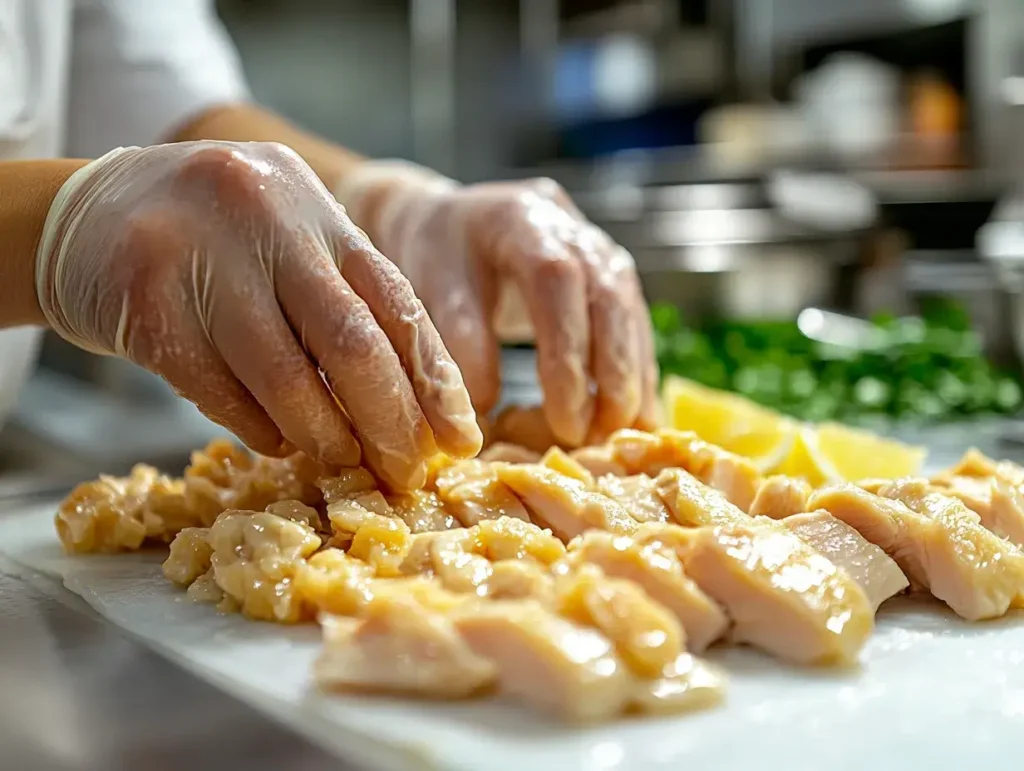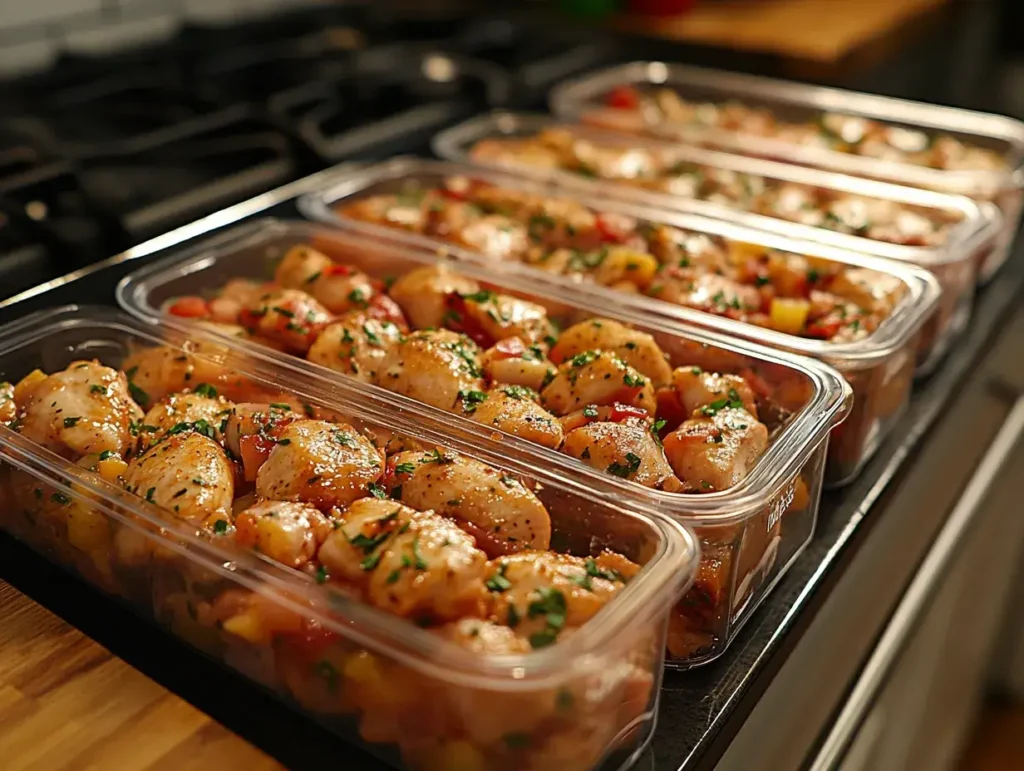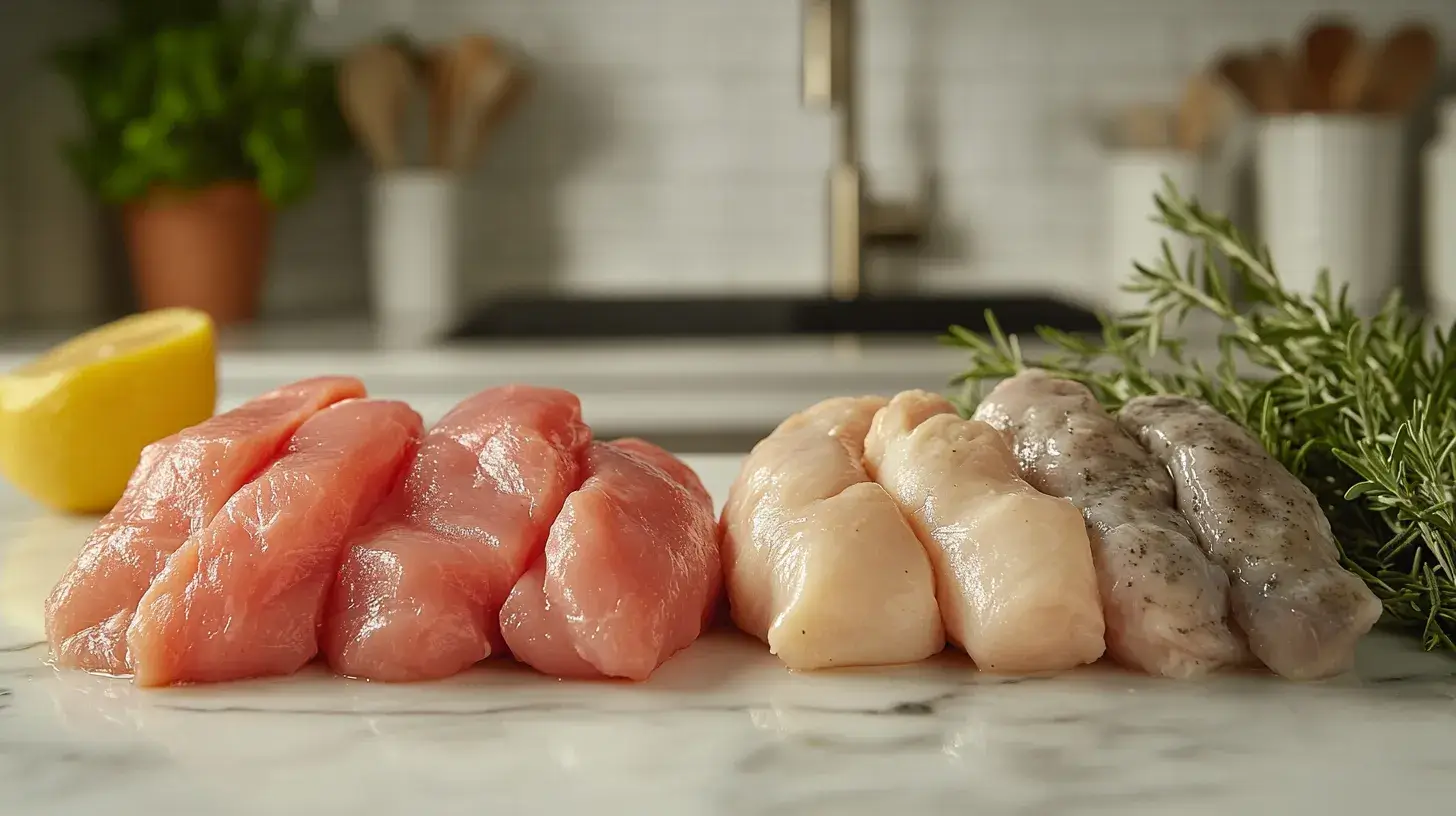Ever wondered how to tell if chicken has gone bad? It’s a question many home cooks grapple with, and for good reason. After all, fresh vs. spoiled chicken can sometimes be tough to identify at first glance. However, there are several telltale signs like color changes, off smells, and even slimy surfaces that reveal when poultry has crossed into risky territory. In this article, we’ll cover everything from spotting rotten chicken signs in raw meat to detecting subtle spoilage in cooked leftovers. Plus, we’ll discuss safe chicken storage and foodborne illness prevention tips, so you’ll feel more confident that your next meal is both tasty and safe.
Table of Contents
Understanding Chicken Food Safety
Why Proper Handling of Poultry Is Crucial
Chicken is a protein powerhouse, but it’s also a prime target for bacteria like Salmonella in poultry and Campylobacter. These nasty pathogens thrive in moist, protein-rich environments, and once they make themselves at home, they can cause serious illnesses. Consequently, you’ve got to handle chicken with care—keeping it chilled, sealed, and separate from other foods. By doing so, you drastically cut down on cross-contamination and keep your kitchen a safer place.
Moreover, the risk of rancid chicken odor or spoilage skyrockets when storage practices aren’t up to par. For instance, leaving raw chicken in a warm environment accelerates bacterial growth, making it easier for meat to develop that bad poultry smell and slimy texture. Thus, always store poultry under 40°F (4°C) in your fridge and follow proper thawing methods if you’re taking it from freezer to plate. Not only will this preserve flavor, but it also keeps potentially harmful microbes at bay.
Common Misconceptions About Fresh Chicken
Many people assume that buying organic or free-range guarantees perfect quality. But it’s important to realize that expiration dates on chicken and sell-by labels aren’t foolproof. Yes, the label may offer a rough guide, yet checking raw chicken freshness goes beyond simply reading a date. Inspect its color, feel its texture, and pay attention to any unusual scents. Even “high-end” poultry is susceptible to spoilage if mishandled during transport or storage.
Additionally, cooking “bad” chicken at a high heat doesn’t always neutralize every risk. Some toxins and bacteria can survive if they’ve had enough time to multiply. Consequently, knowing how to tell if chicken has gone bad? before you toss it into the pan is key. Ultimately, fresh chicken should have a light pink hue, a clean or subtle meaty scent, and a non-sticky surface—signs that you’re in the clear to prepare a delicious and safe meal.
Visual Signs of Spoiled Chicken
Changes in Color and Texture
Fresh chicken should typically appear pale pink or slightly translucent. However, one crucial spoiled chicken indicator is a grayish or greenish hue that stands out as abnormal. Moreover, you might spot blotchy discolorations indicating possible bacterial growth or mold on chicken. These color shifts usually point to deeper problems within the meat. Therefore, it’s important to discard any chicken that displays such odd hues, as no amount of cooking will reverse advanced spoilage.
Meanwhile, texture offers another clue. Indeed, fresh vs. spoiled chicken can feel quite different. Ideally, raw poultry should be somewhat moist yet firm to the touch. However, if you run your fingers across the surface and notice an unmistakably slimy film, that’s a telltale sign of bacterial activity. Consequently, the meat’s protective qualities are compromised, making it more susceptible to foodborne illness prevention failures. Additionally, chicken that feels sticky or tacky suggests that the proteins have started to degrade, and it’s often best to err on the side of caution by tossing it out.
Properly marinated and stored chicken can stay fresher longer, yet it’s still essential to confirm its color and texture before cooking. After all, knowing how to tell if chicken has gone bad? saves you from the risk of ingesting harmful microbes and preserves the taste you desire.
Identifying Slime or Fuzz

Slime on chicken is almost always an instant red flag. Although raw chicken may sometimes have a slight moisture layer, an excessively gooey residue indicates bacterial build-up. Hence, trust your instincts: if the meat feels unpleasantly slimy, your best move is to discard it without question. Additionally, watch for fuzzy patches, which might look white, bluish, or grayish. These fuzzy growths often occur when chicken has been left in the fridge beyond recommended refrigeration guidelines, and they signal mold or other microorganisms.
Furthermore, slime or fuzz can lead to that awful rancid chicken odor when cooked. Because bacterial and fungal growth accelerates exponentially once it gains a foothold, you’re likely to end up with a meal that smells terrible—and potentially makes you ill. Ultimately, prioritizing visual and tactile checks can keep you one step ahead in the quest for fresh chicken. Thus, whenever you encounter a slimy film or fuzzy spots, do not gamble with your health; instead, get rid of the questionable poultry and protect yourself from possible contamination.
Odor Clues: How to Tell If Chicken Has Gone Bad by Smell
Distinguishing Foul Odors from Normal Chicken Smell
Many cooks focus primarily on color, yet smell is equally telling. In fact, how to tell if chicken has gone bad? hinges heavily on your nose. When poultry is fresh, it should possess a mild, almost neutral, meaty scent. However, a bad poultry smell often has strong sulfur or ammonia-like notes that are quite unpleasant and impossible to miss. Consequently, any whiff that makes you recoil should be taken seriously.
Moreover, a sour or “rotten egg” smell suggests that spoilage bacteria have been feasting on the chicken’s proteins. These microorganisms break down amino acids, producing foul-smelling compounds that warn you something is amiss. Therefore, if you open the package and immediately wrinkle your nose, don’t hesitate to toss that chicken. Holding on to it, hoping the smell will go away, could compromise not only your meal but also your entire kitchen environment.
When a Slight Smell Might Still Be Dangerous
It’s tempting to write off a faint stink as “not that bad,” especially if you’re rushing or trying to avoid waste. Nevertheless, even a hint of sourness is worth a second thought. Certain bacteria can multiply quickly, and they may not always emit a powerful odor at first. In addition, cooking temperatures for chicken can kill some pathogens, yet it won’t always neutralize the toxins produced by bacteria if the meat was spoiled beforehand.
In other words, that slightly musty scent might be a precursor to more serious decay lurking within the muscle fibers. Also, relying on smell alone could cause you to miss other critical signals. For instance, if the chicken smells a bit off and also feels slimy, you have multiple reasons to steer clear. Meanwhile, if you detect a mild but persistent odor, take extra caution. Err on the side of safety because poultry gone bad is never worth the risk. Indeed, food safety guidelines for chicken underscore the importance of trusting your senses and discarding any questionable product.
Checking Packaging and Sell-By Dates
Decoding Sell-By, Use-By, and Expiration Labels
You may think labels on chicken are straightforward, yet these dates can confuse even seasoned shoppers. Typically, sell-by focuses on how long a store should keep a product on the shelf, while use-by points to the last date for optimal quality. Meanwhile, an expiration date often means the product’s safety could diminish past that day. Nevertheless, the packaging alone won’t always reveal how to tell if chicken has gone bad? Instead, use these labels as an initial guide, then inspect the chicken’s appearance, smell, and texture to confirm its freshness.
Furthermore, it’s vital to distinguish the difference between a chicken that has just passed its sell-by date and one that’s genuinely rotten. If you store chicken below 40°F (4°C) and cook it within a day or two of purchase, it often remains safe despite being near or slightly beyond that printed date. On the other hand, if the bird looks off-color or emits a rancid chicken odor, no label can save it. Trust your senses, but also pay attention to the packaging. If the wrap is torn or overly inflated, air and bacteria might have slipped in, speeding up spoilage.
Proper Storage Practices for Poultry
Proper storage is your best defense against ruined chicken. First off, keep raw poultry cold at all times. That means going straight from the grocery store to your fridge or freezer. For longer storage, freezing is ideal, but ensure you wrap the meat tightly in freezer-safe materials. Reducing exposure to air helps prevent freezer burn and preserves both taste and quality.
Moreover, never place raw chicken where its juices can drip onto other foods. Cross-contamination is a real threat, so consider storing your chicken on the lowest shelf in the fridge. Additionally, thawing your poultry in the fridge—rather than on a countertop helps maintain consistent temperatures. If your fridge lacks adequate space or you have leftover cooked chicken, follow official food safety guidelines for chicken by keeping it in sealed containers. For an easy way to transform leftover meat, check out our Best Leftover Rotisserie Chicken Recipes. Adding flavor while ensuring proper storage practices can help you enjoy every bite without risking your health.
Cooked Chicken Considerations: Identifying Spoilage
Visual and Olfactory Checks on Leftovers
When dealing with cooked chicken, one might think the risk of contamination disappears. However, bacteria can still multiply if you leave prepared poultry at room temperature for too long. Watch closely for dull or grayish color, along with odd spots or visible mold. A bad poultry smell can still develop in leftovers, so open your containers and sniff before reheating. If anything triggers your alarm—like sour or foul aromas—toss it immediately.
Additionally, a sticky or slimy coating on cooked chicken indicates probable bacterial growth, which could make it unsafe. Keep an eye on refrigeration guidelines, as cooked poultry generally stays good for about three to four days in the fridge. If you plan to enjoy those leftovers beyond that window, freezing them is usually the smarter option. Just remember to label everything with dates, so you know exactly when to use them.
Safe Reheating and Storage Guidelines

Safe reheating goes beyond simply popping your chicken in the microwave. Aim for a core temperature of at least 165°F (74°C), which kills lingering bacteria. Also, stir or flip the meat partway through to ensure even cooking. If you’re warming your leftovers on the stovetop or in the oven, add a bit of broth or sauce to keep the meat from drying out.
Furthermore, avoid reheating chicken more than once, because repeated warming and cooling cycles create ideal conditions for microbial growth. Store each portion in small, airtight containers to help them chill faster and remain fresh longer. By following these tips, you’ll lower the risk of spoiled chicken and maintain better flavor. In short, how to tell if chicken has gone bad? remains a critical question even with cooked poultry, so trust your instincts, observe the signs, and always practice good kitchen habits.
How to Tell If Chicken Has Gone Bad During Meal Prep
Spotting Bad Chicken Before Cooking
Preparing a tasty meal often starts with checking the quality of your ingredients. Indeed, how to tell if chicken has gone bad? becomes crucial before any seasoning or marinating. First, examine the color and texture. If the chicken looks grayish or oddly discolored, it might already be risky. In addition, run your fingers over the surface. Should you feel a slimy film, that’s a major warning sign. Meanwhile, give it a quick sniff. A bad poultry smell—sour, sulfur-like, or generally unpleasant—signals potential spoilage. Thus, if your senses pick up something off, discard the chicken outright rather than hoping to “cook away” any problems.
Moreover, don’t overlook the packaging details. Even if the sell-by date indicates the chicken is still fine, damage to the wrapping can let in microbes and hasten spoilage. Thus, when you’re rushing through meal prep, take a moment to double-check that the poultry is still safe. Indeed, proper food safety guidelines for chicken stress the importance of visual and olfactory checks prior to cooking. You can prevent a ruined dinner and protect your health by acting swiftly at the first sign of trouble.
Mid-Cooking Checks for Spoiled Poultry
Sometimes, you may only notice concerns after you’ve begun cooking. For instance, if the chicken changes to a strange color during heating, or if a pungent odor suddenly wafts from the pan, you should stop and reassess. Although heat can eliminate some bacteria, it won’t always neutralize the toxins left behind by extensive bacterial growth. Therefore, trust your senses. If the chicken continues to smell foul or appears oddly textured, it’s safer to abandon that batch.
Likewise, if you slice into the chicken and see an unusual interior color or slimy patches even as it cooks, proceed with caution. While discovering how to tell if chicken has gone bad? mid-cooking isn’t ideal, recognizing these red flags early is vital to avoid severe foodborne illnesses. Ultimately, you can always replace questionable poultry, but you can’t undo a spoiled meal—or the sickness that might follow.
Frequently Asked Questions (FAQ)
1. Is It Okay to Eat Chicken That Smells a Little?
Short answer: No. Even a slight, foul odor can point to bacterial activity. In truth, fresh chicken carries a mild scent that is not offensive. Therefore, any sour, sulfur-like, or otherwise off-putting odor is a strong indicator that the meat could be spoiled. Discard questionable chicken to avoid potential foodborne illness prevention failures.
2. How Can You Tell If Chickens Are Spoiled?
You can spot spoiled chicken by checking for a bad poultry smell, slimy texture, or discolored flesh. If you’re still unsure how to tell if chicken has gone bad? after doing a quick scan, trust your instincts. It’s best to reject meat that shows two or more signals of spoilage. Furthermore, pay attention to the expiration dates and ensure proper storage temperatures to reduce the odds of contamination.
3. How Long Can Raw Chicken Last 5 Days in the Fridge? / A Costco Rotisserie Chicken Last in the Refrigerator?
Generally, raw chicken should be used or frozen within one to two days. While some folks push it to three days, the risk of mold on chicken or a rancid chicken odor increases with each passing day. On the other hand, a Costco rotisserie or any store-bought cooked chicken can keep safely in the fridge for about three to four days. After that, bacteria may grow, so consider freezing leftovers if you don’t plan to eat them soon.
4. Can You Taste If Chicken Is Bad?
Although a sour or bitter flavor might be a clue, tasting spoiled meat is risky. By the time you notice the unpleasant taste, harmful bacteria may already be present. Thus, it’s better to rely on visual, smell, and texture checks before ever cooking—much less tasting—chicken that might be bad. Trust your senses early and avoid putting your health on the line.
Preventing Future Spoilage and Final Tips
Best Practices from Purchase to Plate
Preventing spoiled chicken starts at the grocery store. To begin with, always check the packaging for any tears or leaks, since even small openings can invite bacteria inside. Then, place raw poultry in a separate bag to avoid cross-contamination with other items in your cart. Next, rush home and store your chicken in the fridge or freezer right away. Keeping your chicken cold slows down bacterial growth and preserves freshness. Above all, remember how to tell if chicken has gone bad? by relying on those simple checks—sight, smell, and texture.
Once you’re in the kitchen, wash your hands and utensils often. Indeed, raw chicken juice can quickly spread bacteria onto cutting boards, knives, or countertops. Also, cook chicken to an internal temperature of 165°F (74°C) to destroy most harmful microbes. However, cooking won’t remove toxins formed by advanced spoilage, so never try to salvage questionable poultry. When storing leftovers, wrap them tightly or keep them in sealed containers. That way, air can’t circulate and speed up decay.
Smart Meal Planning
Smart planning helps you avoid letting chicken languish in your fridge for days. For instance, purchase only what you need for the week. If your schedule changes, consider freezing unused chicken rather than leaving it to sit. Freezing halts bacterial growth, though it’s still wise to inspect the meat upon thawing. In addition, meal prep can save time while reducing the chance of spoilage. For instance, cooking larger batches and freezing them in individual portions keeps your meals fresh and cuts down on waste.

